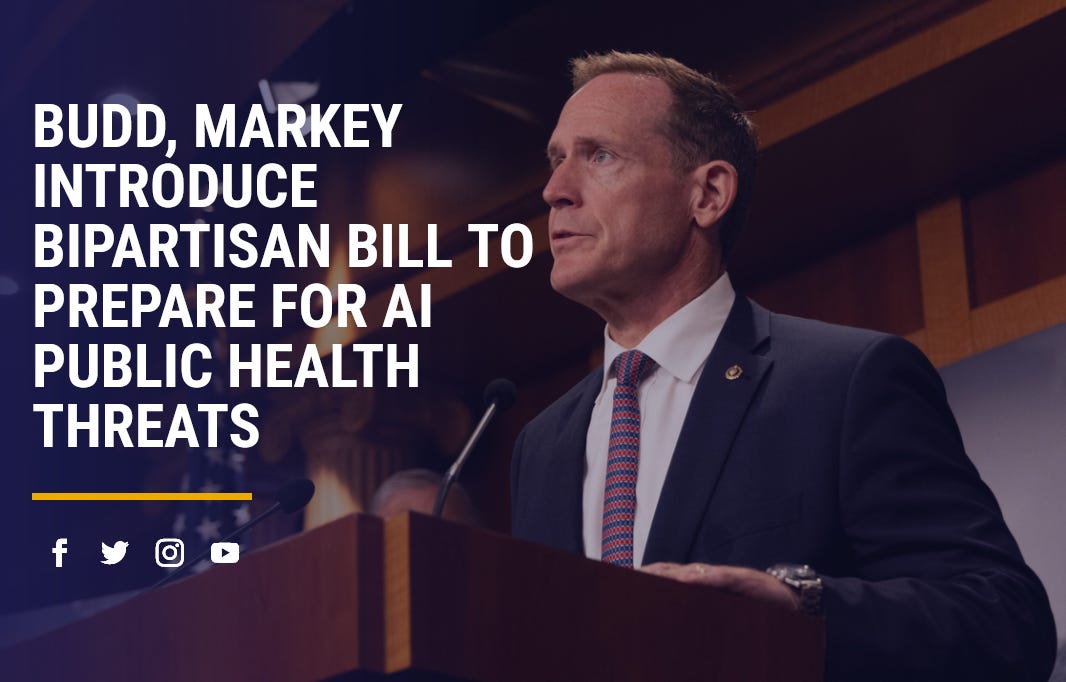Welcome to AI Policy Weekly, a newsletter from the Center for AI Policy (CAIP). Each issue explores three important developments in AI, curated specifically for U.S. AI policy professionals.
Elon Musk’s xAI Releases Its Most Powerful AI Yet
Elon Musk’s company xAI has released its latest AI model, Grok 3.
This is a beta version that will continue to improve—xAI says Grok 3 is “still in training and will rapidly evolve with your feedback.”
It’s initially available to anyone with an X Premium+ account. X Premium+ subscription prices jumped from $22 / month to $40 / month shortly after Grok 3’s release.
xAI also deployed an early preview of a Grok 3 reasoning variant that can “think” before responding. Musk noted that xAI has deliberately obscured the visible thinking outputs “so that our model doesn’t get totally copied instantly.”
Ahead of xAI’s livestream announcement, Musk wrote on X that Grok 3 is the “Smartest AI on Earth.”
That claim is debatable, but Grok 3 does show impressive performance against leading AI models on a handful of specific benchmark tests:
52% on the 2024 American Invitational Mathematics Examination (AIME), a challenging qualifying exam for U.S. high school students seeking to compete in the International Math Olympiad (IMO).
75% on Google-Proof Q&A (GPQA), a multiple-choice test with problems intended to stump science PhDs who have unlimited time and internet access.
44% on SimpleQA, a benchmark that OpenAI published last fall to measure AI chatbots’ propensity to generate factually correct responses and avoid hallucinations.
The reasoning variant scores even higher on math and science tasks: 93% on the 2024 AIME and 85% on GPQA. These scores rival OpenAI’s forthcoming o3 model.
Early impressions from users were mixed, but they might’ve been confounded by an engineering slip-up. xAI co-founder Igor Babuschkin wrote that on Tuesday, one day after the Grok 3 announcement, “we discovered a bug that caused many people to get answers from Grok 2 instead of Grok 3 even though it said Grok 3 in the app 😬.”
To counteract this mistake, xAI recently made Grok 3 available for free “(until our servers melt).” Musk says this will last “for a short time.”
Grok 3’s creation involved remarkable computational power. The xAI team claims to wield 200,000 NVIDIA H100 chips in their Memphis datacenter, nicknamed “Colossus.”
“We’ve been able to use all of these GPUs, use all of this compute to improve Grok,” said Babuschkin.
Specifically, the xAI livestream slideshow proclaimed that Grok 3 used 10x more training compute than Grok 2. Based on data from Epoch AI, this implies that Grok 3 used at least 3 * 10^26 floating-point operations (FLOP), making it the first publicly verified case of a model exceeding 10^26 FLOP.
Musk said that xAI installed Tesla Megapack batteries to handle “dramatic” power fluctuations in the computing cluster. The full electricity demand of Colossus can exceed 200 megawatts, enough to power over 150,000 U.S. households.
Further, xAI is working on a new computing cluster that will draw roughly 1.2 gigawatts (1,200 megawatts) of power, the same as the DeLorean time machine in Back to the Future.
More release notes:
xAI also unveiled Grok 3 mini, a cheaper and weaker version of Grok 3, plus a corresponding reasoning variant.
The X platform has a feature where Grok 2 can explain any post at the press of a button. Going forward, this feature will use Grok 3 (likely the mini version, to save money).
“Big Brain” mode makes Grok think longer to solve harder problems, at the cost of more computation and time.
“Deep Search” mode makes Grok search the internet and use reasoning, akin to the new “Deep Research” agents from companies like OpenAI, Perplexity, and Google.
xAI is launching an AI-powered gaming studio. Musk stated this explicitly in the livestream after Grok 3 creatively designed a new game combining Tetris and Bejeweled, referred to internally as “BeTetrised.”
A voice mode feature is coming soon, using a single model for both listening and talking.
xAI is moving remarkably fast. Musk founded the company less than two years ago.
Rapid AI progress portends rapid societal change. For one thing, AI companions may grow increasingly popular as AI grows more lifelike.
“Honestly, people are going to fall in love with Grok,” said Musk. “It’s like, 1000% probable.”

Meta Decodes Brain Patterns Using AI
Researchers from Meta AI and European universities recently published a paper titled “Brain-to-Text Decoding: A Non-invasive Approach via Typing.”
It presented a new AI architecture, Brain2Qwerty, which can “decode sentences from either electro- (EEG) or magneto-encephalography (MEG), while participants typed briefly memorized sentences.”
Specifically, Meta recruited 35 volunteers who were skilled typists and native Spanish speakers. Each person came to a lab at the Basque Center on Cognition, Brain and Language in Spain. They wanted people who could type without looking at the keyboard, so they tested everyone to make sure they had at least 80% accuracy when typing with the keyboard covered.
For recording brain activity, they used MEG and EEG tools, which measure magnetic fields and electrical activity, respectively.
In each experimental session, volunteers would see Spanish sentences displayed on a screen one word at a time. After seeing each sentence, they memorized it briefly during a 1.5-second waiting period. Then they typed the entire sentence from memory.
Each person went through multiple sessions, typing about 128 sentences per session. In total, Meta collected thousands of sentences and hundreds of thousands of keystrokes across all participants, along with the corresponding brain activity.
The researchers used much of this data to train their Brain2Qwerty AI system. They also set aside a portion for testing.
In testing, Brain2Qwerty tried to guess each typed character based on a 0.5-second window of brain activity surrounding its corresponding keystroke.
Researchers compared these predictions to what the participants had actually typed and calculated the character error rate—how many changes (substitutions, deletions, or additions) are needed to fix the predicted text, expressed as a percentage of the total characters.
The error rate was 32% for MEG data and 67% (worse) for EEG data. Importantly, characters physically close together on the keyboard were more likely to be confused.
For one participant, the error rate was as low as 19%.
This is part of a larger advancement towards brain-reading AI. Already, AI systems can interpret human neural signals to control robots and use computers, reproduce seen images and internal storytelling, and even predict future brain states.
These new technologies have beneficial applications, like decoding thoughts into speech for people with trouble speaking.
But they also carry serious privacy implications. For instance, authoritarian governments could use future versions of these tools to monitor for “thoughtcrime.”
With AI, brainwaves are becoming legible.

Budd, Markey Introduce Bill to Prepare for AI-Powered Biorisks
Senators Ted Budd (R-NC) and Ed Markey (D-MA) recently reintroduced the “Strategy for Public Health Preparedness and Response to Artificial Intelligence Threats Act,” which they also introduced one and a half years ago in the last Congress.
The act is the same as before. It would require the Secretary of Health and Human Services to develop a strategy to address biological risks from the misuse of AI, including:
A “framework for public health preparedness and response” for countering AI threats to national health security.
Metrics for measuring success in meeting preparedness goals.
“Gaps in public health capabilities to achieve such preparedness.”
Strategies to address these gaps and “strengthen public health emergency preparedness” for AI threats.
Strategies to mitigate AI misuse in biological weapons and “the design of viruses and bacteria that are resistant to treatment.”
This is a simple, common sense bill. Top AI companies recognize that forthcoming AI models could pose biological threats—in fact, they are already planning what they will do if that happens. The U.S. government needs to prepare as well.
“As AI grows in power and influence, we may face the real prospect of AI-generated threats like biological or chemical weapons,” said Senator Budd. “We cannot be caught flat-footed on these threats and should begin to prepare now.”
The Center for AI Policy strongly urges Congress and President Trump to enact this bill into law.

CAIP News
From 12–1:30 pm on Monday, February 24th, CAIP will host an advanced AI expo on Capitol Hill, featuring live demonstrations of cutting-edge AI technology from nonprofits and university teams across the country. RSVP here.
Jason Green-Lowe issued a statement on potential mass layoffs at the National Institute of Standards and Technology (NIST).
ICYMI: Claudia Wilson, in collaboration with Emmie Hine of Yale’s Digital Ethics Center, published a research report on open-source AI and relevant policy proposals.
ICYMI: Ep. 15 of the CAIP Podcast features Bill Drexel of CNAS discussing AI, China, and national security.
Quote of the Week
I remember in grad school, [a friend] told me that his New Year’s resolution for 2000 was to live to see the year 3000, and that he was going to achieve this by inventing AI. I was like, ‘Oh, that sounds like a good idea.’
—Noam Shazeer, co-lead of Google’s Gemini AI team and co-inventor of the seminal Transformer architecture
This edition was authored by Jakub Kraus.
If you have feedback to share, a story to suggest, or wish to share music recommendations, please drop me a note at jakub@aipolicy.us.
—Jakub





